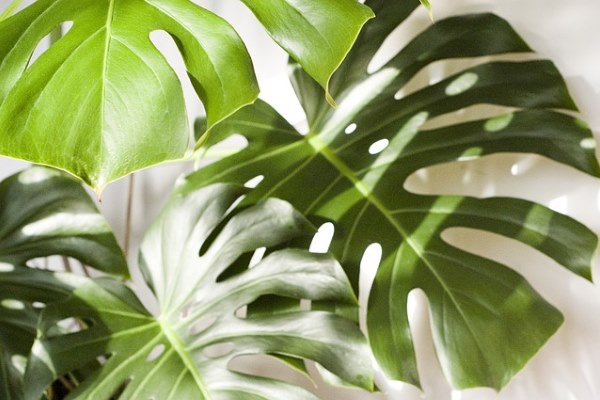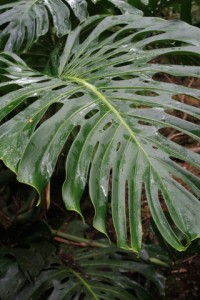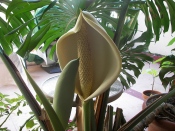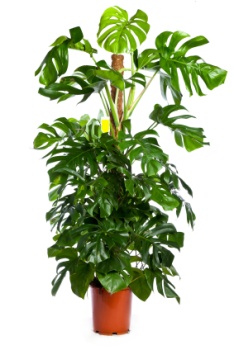Swiss Cheese Plant
Botanical Name: Monstera deliciosa
Lush and bold, Swiss Cheese Plant makes a good accent if you have the space.
Over several years it can grow several feet tall and its dramatic, perforated leaves to 12 inches (30 cm) long or more, so it needs a bit of elbow room. Keep those leaves dust-free and shiny by gently wiping them with a damp cloth.
 Swiss Cheese Plant makes a big impression in a room. Give those leaves space to sprawl out.
Swiss Cheese Plant makes a big impression in a room. Give those leaves space to sprawl out.
Monstera Deliciosa's Tropical Beginnings
This handsome foliage plant is a climber in the wild, scrambling up large trees, anchoring itself with thick aerial roots which also take in moisture and nutrients. You can tuck aerial roots that emerge near its base into the soil and train others to climb a moss pole.
Young plants have smooth leaves. But as Monstera deliciosa matures, the leaves develop deeply cut edges and wide slits. In its native jungle habitat, the slashes, holes and cuts in the large leaves help the plant to withstand strong winds and torrential downpours.
Because of this plant's tropical nature, it likes higher humidity than is usually found in a home. Use a cool-mist room humidifier to raise the humidity around it.
Problems and Solutions
Most problems with Monstera deliciosa will show in its leaves.
- Yellowing lower leaves are a symptom of overwatering. Water thoroughly, then allow soil to dry out a bit before watering again. Use a pot with drainage holes and empty drainage tray.
- Curled, crispy leaf tips could indicate low humidity or too much fertilizer. Flush soil with clean water to wash away any accumulated fertilizer. Wait a month before feeding again.
- If they are not getting enough light, large leaves grow without holes and slits. Give the plant moderate to bright light, but not direct sun.
- Scorched leaves (dry, brown spots) are caused by strong, direct sunlight.

Deliciosa means pleasing, referring to the white spadix flower (shown at right) that develops into edible berries on mature plants grown in tropical Central America. However, Swiss Cheese Plant rarely produces flower and fruit when grown indoors.
CAUTION: The leaves of Swiss Cheese Plant are poisonous and can cause severe burning in the mouth if eaten. They can also cause skin irritation, so I'd recommend wearing gloves when handling this plant.
Repot in spring when roots have filled the pot. Use a pot with drainage holes to prevent soggy soil.
Buying Tips
This big-leafed plant is sometimes called Split-Leaf Philodendron, but that's a different genus. Look for Monstera deliciosa to be sure you're getting this plant.
Swiss Cheese Plant Care Tips

Origin: Southern Mexico and Guatemala
Height: Up to 10 ft (3 m) tall.
Light: Bright light, no direct sun. If leaves on mature plants grow without holes or slits, give the plant more light.
Water: Water thoroughly and allow the top inch of soil to dry out between waterings. Keep soil barely moist in winter. Yellowing lower leaves are usually a sign of overwatering. Provide good drainage.
Humidity: Average to high (at least 40% relative humidity). See these tips for raising the humidity indoors.
Temperature: Average to warm 65-85°F/18-29°C
Soil: Mix 1 part peat moss-based mix and 1 part sand or perlite for good drainage.
Fertilizer: Feed every 2 weeks spring through fall with a balanced liquid or water-soluble fertilizer diluted by half. Feed monthly in winter.
Propagation: Take growing tip cuttings of a mature plant in spring and insert them into moist peat moss based potting mix.


